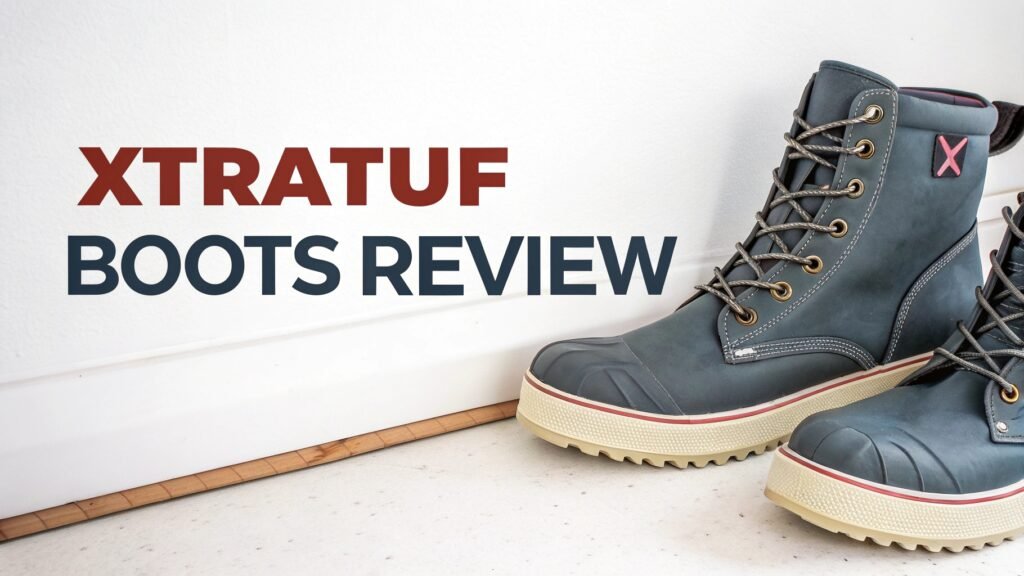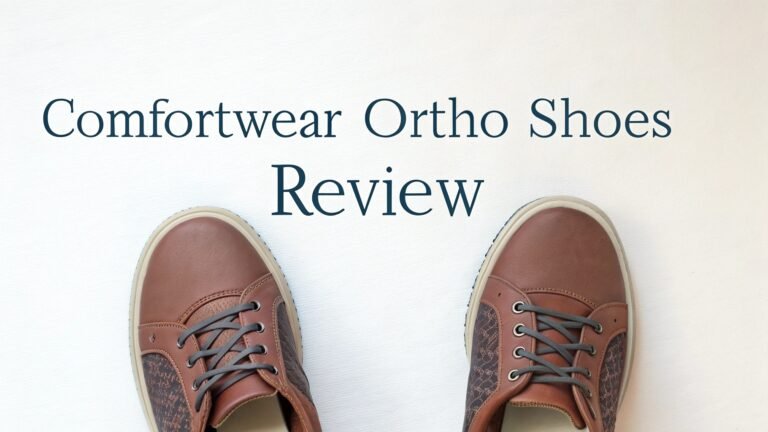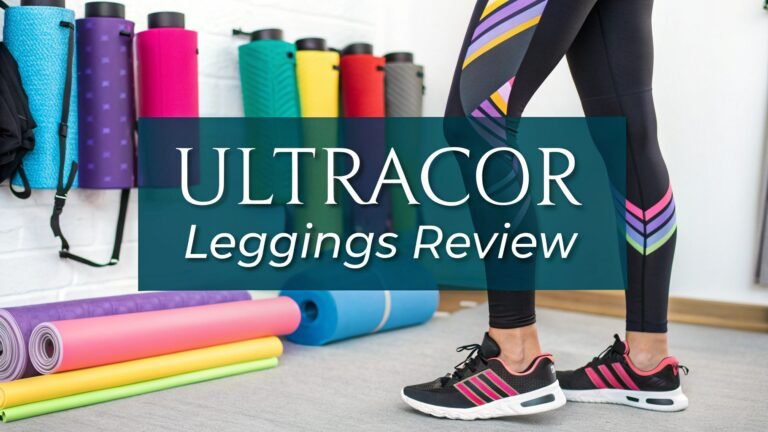XTRATUF Boots Review: Why They Stand Out in All Weather Conditions
Are you tired of wet feet? Do you want boots that work in rain, mud, snow, and on slippery surfaces? XTRATUF boots have gained a massive following among commercial fishermen, outdoor enthusiasts, and everyday workers who need reliable footwear.
These boots are not just another pair of rubber work boots. They represent a legacy of performance in some of the world’s harshest conditions.
With over 50 years of history behind the brand, XTRATUF has earned its reputation as the go-to boot for people who work and play in wet environments.

Key Takeaways
- Legendary Durability: XTRATUF boots are built to withstand harsh conditions with triple-dipped neoprene construction that resists chemicals, acids, and contaminants. Their rugged design makes them last for years even with daily use in tough environments.
- Superior Traction: The signature Chevron outsole provides exceptional grip on wet and slippery surfaces, making these boots ideal for boat decks, docks, and wet terrain.
- Comfort Features: Despite being work boots, XTRATUFs include breathable linings, cushioned insoles, and flex points that make them comfortable for all-day wear.
- Waterproof Protection: The seamless construction ensures 100% waterproof performance, keeping feet completely dry in wet conditions.
- Versatile Options: The XTRATUF lineup includes various heights (ankle, mid, and tall boots), insulation levels (non-insulated and insulated), and specialized designs for different activities.
- Alaska Tested: Known as “Alaska’s boot,” XTRATUFs have earned their reputation in one of the most demanding environments in America, proving their worth in extreme conditions.
- Range of Prices: With options starting around $100 for ankle deck boots and ranging to approximately $170 for insulated legacy models, there’s an XTRATUF for different budgets.
- Easy Care: Simple cleaning with water and soap keeps the boots in good condition, with minimal maintenance required to extend their lifespan.
- Some Manufacturing Changes: After production moved overseas in 2012, some users noted differences in quality, though recent models have addressed many concerns.
- Popular Models: The 6″ Ankle Deck Boot and the 15″ Legacy Boot are the most popular styles, offering different levels of protection for various uses.
The History of XTRATUF Boots
The story of XTRATUF begins in the 1950s in Rock Island, Illinois, where BF Goodrich first commissioned Norcross Safety Products to manufacture these specialized rubber boots.
The original design was created specifically for commercial fishermen who needed footwear that could handle fish oils, salt water, and slippery boat decks. The boots featured a unique chevron outsole pattern that provided unparalleled grip on wet surfaces.
Over the decades, XTRATUF evolved from a specialized work boot to a cultural icon in Alaska. In fact, these boots are often called “Alaska sneakers” because of their ubiquitous presence in the state. Alaskans rely on them not just for fishing but for daily life in a place where rain, snow, and mud are common challenges.
In 2008, Honeywell Safety Products acquired the brand, and in 2011, production moved from the United States to China. This move was controversial among loyal customers who noticed some differences in quality. However, after Rocky Brands took ownership in 2021, there have been efforts to address quality concerns while expanding the product line.
Today, XTRATUF offers a wide range of boots and shoes for men, women, and children, maintaining its core focus on water resistance and slip prevention while adding modern features and styles. The legacy of reliability has made these boots popular far beyond their commercial fishing origins, establishing them as trusted footwear for anyone facing wet conditions.
XTRATUF Boot Construction and Materials
What truly sets XTRATUF boots apart is their unique construction process and materials. The flagship Legacy boots feature a triple-dipping technique that creates a seamless barrier highly resistant to many organic and inorganic acids, chemicals, and contaminants. This process involves dipping the boot shell multiple times in neoprene, a synthetic rubber known for its flexibility and resistance to degradation.
The neoprene material used in XTRATUF boots is specially formulated to remain flexible even in cold temperatures, unlike standard rubber that can become stiff and brittle. This flexibility contributes significantly to the comfort that XTRATUF wearers appreciate. The chemical-resistant neoprene also prevents fish oils and other substances from deteriorating the boot material, a critical feature for commercial fishing applications.
In addition to the neoprene exterior, many XTRATUF models feature an XpressCool antimicrobial lining that enhances breathability and fights odors. This feature addresses one of the common complaints about rubber boots—that they make feet sweat uncomfortably. The moisture-wicking lining helps maintain a more comfortable internal environment.
The outsoles deserve special attention as they represent one of the boots’ most important features. The signature non-marking Chevron pattern provides multi-directional traction that performs exceptionally well on wet surfaces. This design has been tested and proven in some of the most challenging conditions, including the rolling decks of fishing vessels during storms.
From toe to heel, XTRATUF boots reflect purpose-built design choices that prioritize function while still offering comfort for extended wear. The materials and construction work together to create footwear that truly lives up to the “extra tough” name.
Check Out This Product Here
Popular XTRATUF Boot Models
The XTRATUF product line has expanded significantly over the years to address different needs and preferences. Here are the most popular models that have earned loyal followings:
The 15″ Legacy Boot represents the original design and remains the gold standard for commercial fishermen and others working in constantly wet environments. These full-height boots provide maximum protection and feature the classic brown exterior with a distinctive tan interior that becomes visible when the tops are rolled down. The Legacy boots include a built-in heel counter and arch support for all-day comfort.
The 6″ Ankle Deck Boot has become extremely popular for recreational use and less demanding work environments. These boots offer the same slip-resistant outsole and waterproof protection in a more versatile, lower-cut design that’s easier to put on and take off. The ankle height provides sufficient protection for most wet conditions without the bulk of taller boots.
For those dealing with cold weather, the Ice Fleece Lined models add insulation to the waterproof protection. These boots feature a comfortable fleece lining that provides warmth down to -10°F while maintaining the same exterior durability and traction.
Comfort and Fit Considerations
When it comes to comfort, XTRATUF boots challenge the stereotype that rubber boots must be uncomfortable. Many users report that these boots are surprisingly comfortable for all-day wear, especially compared to other waterproof boot options. The ergonomic design includes several features that contribute to this comfort.
The rounded toe box provides ample room for toes to move naturally without being compressed. This simple but important design choice prevents the discomfort that comes from narrow, tapered toe boxes in many other boots. Additionally, the flex points in the boot are strategically positioned to allow for natural foot movement during walking.
Most XTRATUF models include cushioned, removable insoles that provide shock absorption and support. Many users choose to replace these with aftermarket insoles for enhanced comfort or specific support needs. Users who spend long days on their feet particularly appreciate the ability to customize the interior with specialized insoles.
Regarding fit, XTRATUF boots generally run true to size, though the company recommends sizing up if you typically wear a half size. For example, if you normally wear a men’s 10.5, you should order a size 11. The boots are designed to be worn with socks of varying thickness depending on the weather conditions.
Performance in Various Conditions
XTRATUF boots truly shine when conditions get challenging. In rainy environments, the waterproof construction keeps feet completely dry even during extended exposure. Users report standing in water for hours without any leakage, a testament to the quality of the seams and materials.
On slippery surfaces, the Chevron outsole pattern provides confidence-inspiring traction. Commercial fishermen particularly value this feature when working on wet, pitching boat decks where a fall could be dangerous. Recreational users appreciate the same traction when navigating slick docks, wet rocks, or muddy terrain.
In muddy conditions, the smooth rubber exterior sheds mud easily rather than collecting it like boots with aggressive tread patterns sometimes do. This self-cleaning quality means less weight buildup on the boots during use and easier cleaning afterward.
Cold weather performance depends on the model chosen. The standard non-insulated versions provide adequate warmth for temperatures above freezing when worn with appropriate socks. For colder conditions, the insulated models offer protection at temperatures well below freezing.
One performance area where some users note limitations is in extremely hot weather. Like most waterproof rubber boots, XTRATUFs can become warm during hot days, though the breathable lining in newer models helps mitigate this issue somewhat. This limitation is common to all waterproof boots and reflects the inherent tradeoff between waterproof protection and heat management.
For specific work environments, XTRATUF offers specialized features like chemical resistance, electrical hazard protection, and steel toe options. These targeted performance features make certain models appropriate for industrial applications beyond fishing and general outdoor use.
Durability and Longevity
XTRATUF boots have built their reputation on durability, with many users reporting years of service from a single pair. The triple-dipped neoprene construction creates a seamless, highly resistant exterior that stands up to repeated exposure to water, chemicals, and physical stress. The reinforced construction in high-wear areas adds to the overall longevity.
Commercial users who put their boots through extreme conditions typically report getting 1-2 years of daily use before replacement, which is impressive considering the harsh environments. More casual users often report 5+ years of service from their boots when used regularly but not daily in extreme conditions.
Some users noted a decline in durability after manufacturing moved overseas in 2011. Common complaints included faster cracking along flex points and sole separation issues. However, more recent reviews suggest quality has improved under new ownership, with many of these issues being addressed in current production.
The key stress points in any boot are the seams and flex areas. XTRATUF addresses these vulnerable areas with reinforced construction and seamless design where possible. The connection between the upper and the sole remains the most common failure point after extended use, though this is typical of most boot designs.
Proper care extends the life of XTRATUF boots significantly. Simple actions like rinsing off salt water or chemicals, allowing boots to dry naturally at room temperature rather than near heat sources, and storing them upright all contribute to longer service life. Users who follow these basic maintenance steps consistently report longer boot lifespans.
Value and Price Considerations
XTRATUF boots represent a significant investment compared to basic rubber boots, with prices ranging from approximately $100 for ankle models to $170+ for insulated legacy boots. This premium pricing raises questions about value – are they worth the extra cost?
For professionals who rely on their footwear daily in challenging conditions, the consensus is clear: the performance benefits and durability justify the price. Commercial fishermen, dock workers, and others working around water consistently report that cheaper alternatives simply don’t last or perform as well, making XTRATUFs the more economical choice over time despite higher initial costs.
For casual users, the value equation depends on frequency of use and specific needs. Weekend boaters or occasional hikers in wet conditions might find the price harder to justify if the boots will see limited use. However, those dealing regularly with wet conditions, even for recreational purposes, often find the comfort and performance worth the investment.
Where to Buy XTRATUF Boots
XTRATUF boots are widely available through multiple retail channels. The official XTRATUF website (xtratuf.com) offers the complete product line with detailed information about each model and direct shipping options. Purchasing directly from the manufacturer ensures you’re getting authentic products and provides access to the full warranty.
Major outdoor retailers like REI, Bass Pro Shops, and Cabela’s typically carry a selection of popular XTRATUF models in their physical stores and online. These retailers often have knowledgeable staff who can help with fit and model selection based on your specific needs.
Sporting goods stores with fishing departments, such as DICK’S Sporting Goods, frequently stock XTRATUF boots, particularly in regions where fishing is popular. These stores may offer seasonal sales that provide opportunities for savings.
Online marketplaces like Amazon carry a wide range of XTRATUF models, often with competitive pricing and customer reviews that can provide additional insights into specific models. When purchasing through third-party sellers, be cautious to ensure you’re getting authentic products.
XTRATUF Boots for Different Activities
While XTRATUF boots originated in commercial fishing, they’ve expanded to serve many different activities and professions. Understanding which model best suits specific uses can help you make the right selection.
For commercial fishing and maritime work, the 15″ Legacy Boot remains the standard. The full-height design provides maximum protection for those who work in consistently wet environments where water depth is unpredictable. The chemical resistance and superior traction are essential for safety on vessels.
Recreational fishing enthusiasts often prefer the 6″ Ankle Deck Boot, which offers sufficient protection for wading in shallow water while providing more comfort and flexibility for walking longer distances between fishing spots. These boots are particularly popular among shore and dock fishermen.
For general outdoor activities like camping, hiking in wet conditions, and garden work, the Ankle Deck Boot or Ankle Deck Boot Sport provides the right balance of protection and comfort. The lower height makes them more versatile for varied activities while still keeping feet dry.
Farmers and ranchers appreciate the durability and chemical resistance of XTRATUF boots when working with livestock and in muddy conditions. The ease of cleaning makes them practical for daily farm chores where boots get heavily soiled.
Common Criticisms and Limitations
While XTRATUF boots have many devoted fans, they’re not without criticisms. Understanding these potential limitations helps set realistic expectations and determine if they’re right for your needs.
One common complaint involves heat management in warm weather. Like most waterproof boots, XTRATUFs can become warm during hot days, potentially causing foot discomfort through sweating. While the XpressCool lining helps mitigate this issue, it remains an inherent limitation of waterproof footwear.
Some users note that the boot weight can cause fatigue during long days of walking. The materials that provide durability and protection add weight compared to lighter footwear options, representing a tradeoff between protection and lightness.
After production moved overseas in 2011, some longtime users reported a decrease in quality, particularly noting faster cracking and sole separation. While recent reviews suggest quality has improved under new ownership, this remains a concern for some customers with long histories with the brand.
Personal Stories: Real-World XTRATUF Experiences
The true test of any footwear comes from those who rely on it daily. Commercial fisherman Jake from Alaska shares, “I’ve worn XTRATUF Legacy boots for over 15 years on fishing vessels. Nothing else comes close for deck grip when you’re working in rough seas. I typically get about 18 months of hard daily use before needing replacement, which is impressive given the conditions.”
Farmer Sarah from the Pacific Northwest notes, “My ankle XTRATUFs have become my go-to boots for daily chores. The fact that I can step in mud, manure, and puddles and then easily hose them off at the end of the day makes farm life much easier. The comfort level is surprising for waterproof boots.”
Recreational boater Michael explains, “As someone who spends weekends on the water, I appreciate that my XTRATUFs don’t mark up the deck but still give me confident footing when things get wet. The ankle height is perfect for my needs without the bulk of taller boots.”
Garden enthusiast Lisa shares, “Gardening in the Pacific Northwest means dealing with rain constantly. My XTRATUF ankle boots have transformed my gardening experience. I can work comfortably for hours without worrying about wet feet, and they’re much more comfortable than traditional rain boots.”
Frequently Asked Questions
Are XTRATUF boots good for snow?
XTRATUF boots perform well in light to moderate snow. The non-insulated versions provide adequate protection for brief exposure, while the insulated models are suitable for extended time in snowy conditions. The Chevron sole provides good traction on snow, though specialized winter boots might offer better performance on ice.
How long do XTRATUF boots typically last?
Lifespan varies significantly based on use conditions. Commercial users report 1-2 years of daily use in harsh environments, while casual users often see 5+ years of service. Proper care and maintenance significantly extend the useful life of the boots.
Are XTRATUF boots comfortable for all-day wear?
Most users find XTRATUF boots surprisingly comfortable for waterproof footwear. The flexible neoprene material, cushioned insoles, and anatomical fit contribute to all-day comfort. Many users replace the standard insoles with premium aftermarket options for enhanced comfort during extended wear.
Should I size up or down for XTRATUF boots?
XTRATUF recommends sizing up if you typically wear a half size. For example, if you wear a men’s size 10.5, order a size 11. The boots are designed to be worn with socks, and most users find they fit true to size when following this guidance.
Where are XTRATUF boots made now?
Currently, XTRATUF boots are manufactured in China. Production moved overseas from the USA in 2011 when Honeywell owned the brand. Rocky Brands acquired XTRATUF in 2021 and has continued overseas production while addressing quality concerns from previous manufacturing.
Hi i’m Mia Jenkins a fashion trend expert with a passion for self-expression and creativity. With a keen eye for style and a deep understanding of the latest trends.







